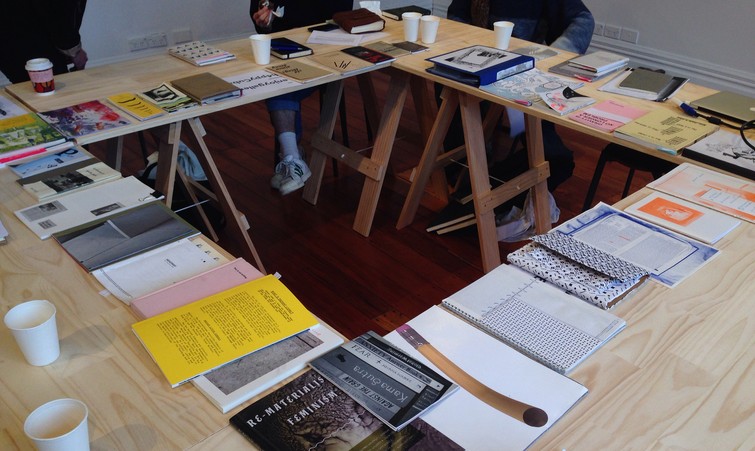Enjoy
Blog
Contents
What is the role of an editor?
September 08 2016
Alice Tappenden, one of the editors of the Enjoy Occasional Journals The Dendromaniac and Love Feminisms, hosted the first session in our Self-Publishing Mini-series.
Below is a selection of notes and resources from the workshop. While do not address all of the skills and complexities of editing, they offer a number of ideas to consider throughout the editing process.

“Curating” the publication
- Establish a cohesive theme or identity
- Consider how the reader will experience the publication, placing texts and images in a logical/deliberate order
- Possibly write an introduction that contextualises the publication, sometimes introducing each contributor’s piece
- Understand your audience
- Use your experience to add value to the publication
- Ensure the ideas are accessible to the public (or the publication’s readers)
- Keep the overall vision in mind when editing
Overseeing the process
- Put out a call for submissions, or select and invite writers/artists/designers
- Set parameters/a brief for design and publication method
- Set parameters for contributors (word count, indication of style)
- Find funding if necessary
- Establish an overall plan and timeline (what’s going to happen and when) and communicates this to contributors. Ensures things happen on time
- Manage passing content to designers/printers and check in at the end of these stages to ensure everything has been done correctly
- May copyedit the pieces, or pass them on to another copyeditor depending on the size of the team (it’s ideal to have someone else do a final copyedit to check for things you may have missed)
Communicating and having good relationships with contributors
- Check in with contributors regularly, and near important deadlines
- Develop an ongoing dialogue with writers about clarifying and developing ideas and manages this relationship
What are some of the qualities or things that great editors have/do?
- Versatility and knowledge of different writing styles
- Respect and understanding for the writer’s intentions and concept
- Elegance and ability to condense and crystalise ideas
- Honest, transparent and objective
- Can provide constructive criticism, being able to both articulate/communicate their own intent/ideas as an editor and be able to reflect on this
- Makes themselves available for brainstorming
- Is wary of or can acknowledge their own personal preferences
- Listens to feedback
- Is able to work collaboratively
- Is creative e.g how do you change that sentence to work without destroying its original meaning or how the writer likes to express themselves?
- Can leave the writing alone if it’s good enough—sometimes this is an act of modesty!
- Has excellent understanding of grammar and spelling (or a great copyeditor!)
- Understands their audience and their publication
- Knows when to pass the text on for another opinion
- Says thank you! Invite people to the launch; tell them what’s happening, both involving writers in the publicity and utilizing their networks
What are the notsogreat things?
- Doesn’t have a clear understanding of their audience or the author’s intentions
- Brings their personal preferences and opinions to the work, subsuming the author’s voice
- Makes arbitrary changes that they can’t explain
- Makes changes without consultation
- Not enough care and attention
- Bad at managing and communicating with writers
- Disorganised
- Likes unnecessary jargon
- Has a narrow vision—can’t let the publication be guided or changed
- Has unrealistic expectations of their writers and/or doesn’t establish clear expectations
- Ignores their writer’s suggestions
- Lack of respect
- Either focuses entirely on little things or entirely on the big stuff
Questions to ponder
- Is editing a creative act?
- Do you have to agree with something to publish it?
- What’s the difference between editing and proofreading?FN-1
Additional Resources
(in part taken from I will need words | A list of helpful tools compiled by Rebecca La)
Style Guides
Create a simple style guide so anyone working on the text knows the editing decisions you’ve made or a publisher or organisation may have an in-house style guide you can follow and add to.
Association of Art Editors Style Guide
Watch out for American usage, spellings, serial commas, etc
New Zealand Ministry for Culture and Heritage
Dictionaries and thesauruses
Google Ngram (for word usage through the ages)
Glossaries of art terms
Media College (for new media)
Recommended Reading
The Elements of Style by Jr William Strunk
Authority and American Usage by David Foster Wallace
Between You and I: Confessions of a Comma Queen by Mary Norris
(you can view her web series here or the premiere below)
Woe is I: The Grammarphobe's Guide to Better English in Plain English by Patricia T. O’Connor
The Subversive Copy Editor: Advice from Chicago (or, How to Negotiate Good Relationships with Your Writers, Your Colleagues, and Yourself) by Carol Fisher Salle
How to Write About Contemporary Art by Gilda Williams
Stet: An Editor's Life, Diana Athill
On Writing: A Memoir of the Craft by Stephen King
-
1.
Editing is the first task that should be undertaken after finishing the first draft of a piece of text. It involves checking the content of the text to ensure that the ideas are expressed clearly and logically, and form a coherent and meaningful whole. Proofreading involves checking over the text in finer detail after the editing stage, to detect errors in spelling, punctuation, grammar and format.
From the Oxford Learning Institute Guide to Editing and Proofreading
